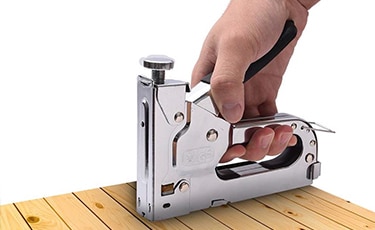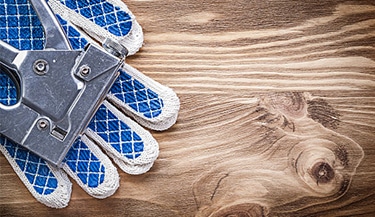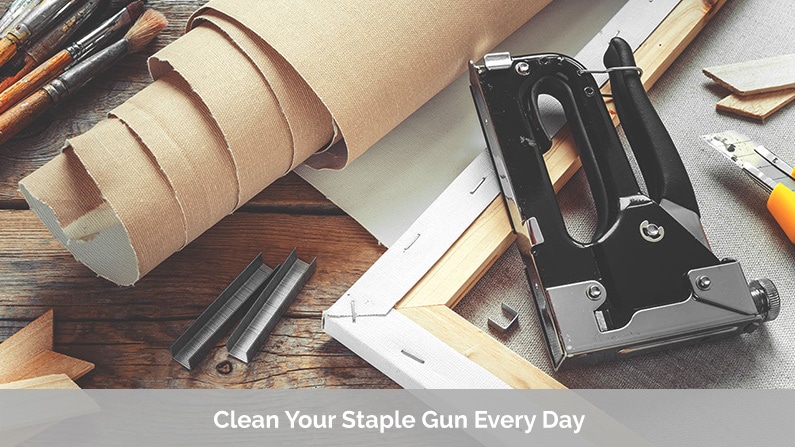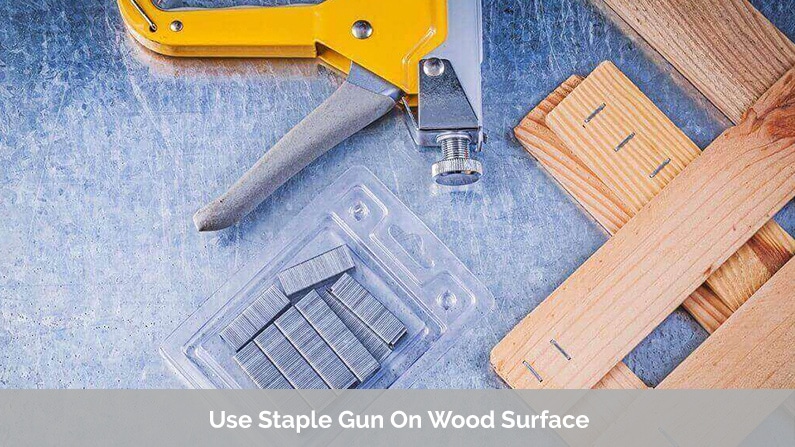Carpentry skills are always in high demand, and whether you’re looking to invest in a carpentry project as a hobby or for a professional job, it’s important to know how to properly handle a staple gun. Since they are extremely popular pieces of equipment, staple guns can be found at every hardware store and at almost every carpentry or furniture crafting shop. These power tools are essential to the efficient furniture-building process. They are the most recommended furniture-building tool by carpenters, as the sturdiness of the industrial staple is unmatched by any nail or pin.
This is the best power tool for keeping your woodwork and upholstery securely fastened together. When you use a staple gun right, your furniture can last a lifetime.
t
So, how exactly do you use a staple gun?
t
Or, more importantly, how do you not use a staple gun?
In this quick guide, we’ll cover the do’s and don’ts of staple guns. Remember, a staple gun is different from a nail gun – as you can see in our informational article here – but its safety and handling rules are very much the same.
Before investing in your next furniture-building project, check out this simple how-to guide to make sure that you are being safe and knowledgeable at all times. Here are the do’s and don’ts of staple guns!
DO: Understand The Anatomy of a Staple Gun
Staple guns use a system of compressed air which can rapidly and powerfully shoot staples into wood. You should understand how this air compression system works, and what part of the tool it comes from.
Normally, a staple gun comes attached to a motor with a cord. Sometimes, the motor is attached to the gun part itself. You can see and hear the motor running in order to make the compressed air system function.This part will resemble the back of a hair dryer, with a ventilation and fan system working to heat and cool the motor at once.
Staple guns that use compressed air systems are known as pneumatic staple guns. Other types of staple guns include electric and manual guns, although compressed air staple guns are by far the most popular and widely sought-after guns in the carpentry world.
Your staple gun should have an apparent trigger, much like the handle of an actual gun. This is what you can press when you want to release one of its industrial staples. These staplers will release a staple very quickly, so be sure that you’re prepared before pulling the trigger.
DO NOT: Use a Staple Gun Without Protection
Just like we mentioned in our table saw safety tips article, you should never use a staple gun without applying the proper protection fist. We recommend putting on your best pair of impact-resistant eyewear glasses before turning on your staple gun. Since stapling or upholstering your furniture requires you to get up close and personal with your work, your eyes are only inches away from this powerful, fast-acting tool. You must stay protected or risk losing your vision.
Remember that staples come out of a lightning-fast air compressor, and when the staples shoot out, they are determined to punch the first thing they come in contact with. Plus, if you’ve been in the furniture industry for a while, you know how permanent those staples can be once they’ve made it to their destination. Stapling yourself in the eye is quite the unappealing experience, to put it mildly.
It doesn’t hurt to put on a pair of slim yet durable protective gloves as well. You never know when you will accidentally drop the gun and send a staple flying somewhere it shouldn’t be going.
Armor up before investing in your next project.
DO: Use Dry and Clean Air to Power the Staple Gun
There’s been debate about what kind of air can be used to best fuel your staple gun. But the simple truth is that anything other than clean, dry air will damage the gun and cause some pretty dangerous conditions. Using other kinds of air or gaseous materials can make a variety of events happen, from killing the gun to causing an explosion. No amount of safety gear would be able to protect you from that!
Try to stay away from the following materials when powering your pneumatic stapler gun: ● Oxygen. Pure oxygen can be extremely hazardous, not only to the staple gun, but to yourself as well. In its pure form, oxygen is actually a toxic gas. It can start fires as well, so it’s best to steer clear of oxygen as a refueling option. ● Carbon dioxide. Again, this can be dangerous in its natural state. Carbon dioxide can cause explosions and spontaneous fires. If you attempt to fuel your staple gun with carbon dioxide, it will likely not work, and you may have a disaster on your hands. ● Compressed gas. Compressed gas is very different from compressed air. Do not ever attempt to fuel your staple gun with compressed gas, no matter what type of gas it is.
Just stick with clean air to power the compressed air filter. As long as you’re in a well-ventilated environment, the motor should do the work on its own. You don’t have to worry about what kind of air you’re going to feed the gun in order for it to work.
DO NOT: Point the Muzzle of the Gun At Anyone
There’s a reason why these tools are referred to as guns. This is because they very much act in the same way as a weaponized gun. They use a compression and release system to rapidly shoot out an object at powerful speeds. This is what creates such a powerful and permanent impact once the object reaches its destination.
s
Do not ever point the staple gun at yourself or anyone else. In fact, try not to point it at eye or horizon level either. You should always keep the gun pointed down and away from yourself and others. The most crucial moment to keep this in mind is when you are connecting the air compressor to the gun when you begin use. Do not take its mechanisms for granted; you never know when you can accidentally shoot out a staple.
The best way to get into the habit of practicing staple gun safety is to treat it as if it were a real gun. You may have heard the phrase, “Always assume the gun is loaded”. The same is true for staple guns. Don’t play around with it or point it where it shouldn’t be, even if it is turned off, or the safety is on, or you think it isn’t loaded.
DO: Inspect Your Staple Gun Every Day
A tool is only as good as the sum of its parts. If one part isn’t in working order, the rest of the gun won’t function well. Make sure that the screws are tightened, the caps are fitted, the motor is working correctly, and the air compressor is connecting as it should. Give your staple gun a good cleaning every day – especially if you are planning to use this gun on a very frequent basis.
Cleaning your staple gun involves keeping it well oiled. Think of it like a vehicle. If the parts aren’t oiled, they don’t work properly. Oil to a staple gun is like blood to the body. When you take care of it, it will function well for you for many years to come.
DO NOT: Use the Gun if a Part Isn’t Working
As a follow-up to the previous section, if during your inspection you find that some of the parts aren’t working, you should immediately send in for repair. Do not attempt to use your staple gun if there are certain inoperable parts. Checking for inoperable parts includes: ● Seeing if the trigger, safety, or staple gun springs are working correctly – if they are not, it is time to take it in for a repair. ● Listening for unusual noises or clicking sounds. ● Watching to see if the gun acts abnormally when you attempt to use it. If any of these instances should occur, it’s better to not risk your safety. Turn the gun off, disconnect its parts, and try to fix it as soon as possible.
DO: Fire Staples into the Wood
A staple gun does not work properly on any material other than wood. It is essential that you use your staple gun on just your work surface, and nothing else. If you try to use it on a material harder than wood, the staple may become ruined, or it may ricochet off the surface and hit you in the eye. Keep control of your gun at all times. This is one of the most important statements that we can make. Losing control of your gun can result in sloppy work, bent staples, and, in a worst-case scenario, an injured person.
DO NOT: Use the Staple Gun as a Hammer
Do not ever use your staple gun for anything other than what it is intended for. If you try to use it as a hammer, a screwdriver, a drill, or even a nail gun, it will result in improper use and can seriously hurt someone. These tools are designed specifically for their intended use. A staple gun is meant to provide large fasteners which can accurately hold pieces of wood together when building furniture. As long as you follow all safety instructions and do not tamper with the gun, you are on your way to investing in a successful carpentry project.
Take These Tips to Heart!
Our Tool Nerds team is passionate about helping you make the right choices and find the right tools and equipment for your favorite projects. We know how popular certain air-compressed tools like staple guns are becoming in the modern industry, and as you invest in exciting new opportunities, we want to make sure that you are staying safe at all times. This simple list of do’s and don’ts should help you figure out the best way to use your staple gun.
If you’re interested in learning more about staple guns, you can check out our other staple gun articles here. Now you’re well on your way to building some great pieces of furniture!
The post The Do’s and Don’ts of Staple Guns appeared first on Tool Nerds.
from Tool Nerds http://ift.tt/2nisuXv
via
IFTTT




No comments:
Post a Comment